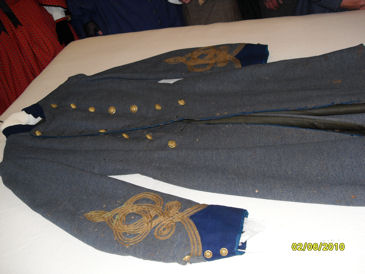Colonel Leventhorpe's Frock Coat
Collett Leventhorpe was an English Officer who immigrated to the United States, attended medical school in Charleston, SC and offered his military services to his adopted state when North Carolina seceded in 1861. His community standing and military background won him the rank of colonel in the 34th North Carolina Infantry. He spent the early months of the War drilling and disciplining the regiment and by December he was given temporary command of a brigade. During the winter of 1861-62 he was at Fort Branch near Hamilton, North Carolina guarding the Roanoke River and the Weldon Railroad Bridge. In April 1862 he was transferred to the 11th North Carolina, elected its colonel and was sent to the Atlantic coast to head the District of Wilmington. Later that year he manned the defenses along Virginia's Blackwater River. Returning to North Carolina in December, he led his troops impressively at the Battle of White Hall, which slowed Federals under Brigadier General John G. Foster in their advance toward Goldsboro, North Carolina. In mid-December, Leventhorpe's 11th North Carolina was attached to the brigade of Brig. Gen. J. Johnston Pettigrew. After helping repulse an attack during the Siege of Washington, in April 1863, Pettigrew's Brigade joined General Robert E. Lee's Army of Northern Virginia for the Gettysburg Campaign as part of Major General Henry Heth's division in Lieutenant General A. P. Hill's Corps. With the rest of Heth's command, the 11th North Carolina participated in the July 1 fighting at the Battle of Gettysburg. With the 11th in the center of the Brigade stepped off in perfect line, with Leventhorpe on foot in the lead. Leventhorpe led 617 men of the 11th into battle crossing Willoughby Run and up the following slope engaged the Federal forces on McPherson's Ridge Leventhorpe was seriously wounded in fighting against the Iron Brigade after flanking the 19th Indiana along Willoughby Run.
'The 11th North Carolina, Colonel Leventhorpe commanding ... displayed conspicuous gallantry, of which I was an eye-witness, and the whole Brigade fought as well and displayed heroic courage as it was ever my fortune to witness on a battlefield.' The fighting at this point 'was terrible - our men advancing, the enemy stubbornly resisting, until the two lines were pouring volleys into each other at a distance not greater than 20 paces.' During this attack, due to his size, nearly 6' 6" and known to be erect and stately in bearing he was a conspicuous figure 'towering over his fellow soldiers like Saul' Leventhorpe was seriously wounded in fighting against the Iron Brigade after flanking the 19th Indiana south of Herbst's Woods, hit by minie balls which splintered his arm and shattered his hip.

The battle flag that Col. Leventhorpe led the 11th NC Regt under during the battle of Gettysburg is now on display at the NC museum of history in Raleigh, NC. It was conserved through the dedicated efforts by the members of 1st NC Volunteers/11th NC Regt. (living historians/reenactors). This group is now in the process of gathering the funds to conserve the frock coat worn by Col. Leventhorpe wore during the action described above. As with many artifacts that are textiles, time is of the essence to stop the deterioration and allow Col. Leventhorpe's frock to complete the story of a flag, their leaders and the men who fought under them. You generous contribution will assist in allowing this story finally be completed and heard. Many thanks.
Sources:
http://en.wikipedia.org/wiki/Collett_Leventhorpe
http://home.freeuk.com/gazkhan/leventhorpe.htm



